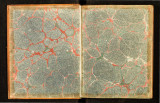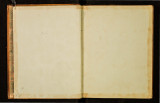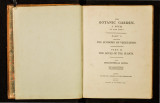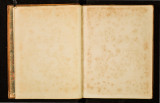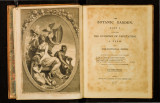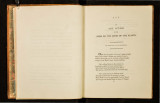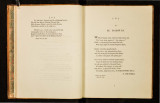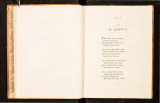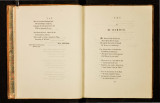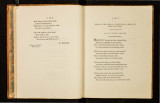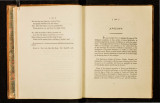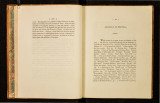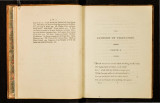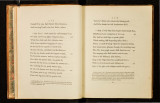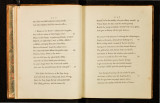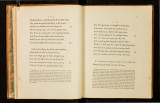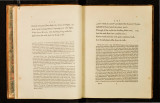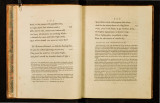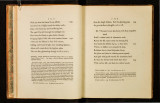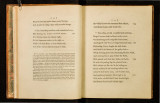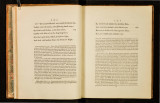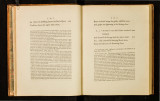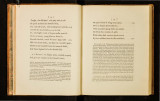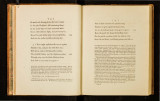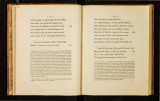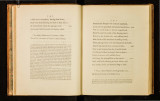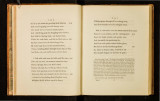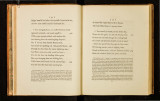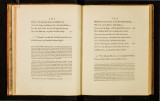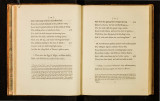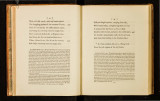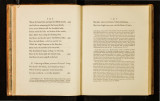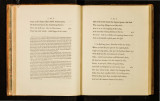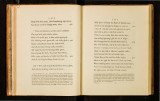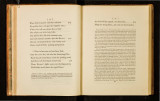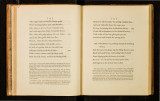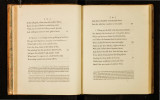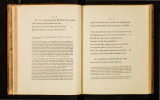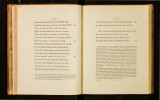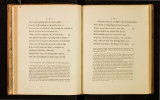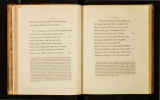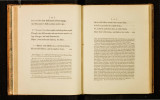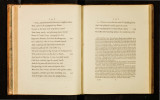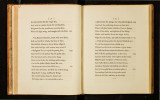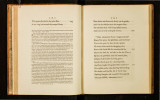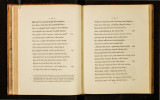| OCR Text |
Show ( IB NOTE IX.--LUMINOUS INSECTS. Star of the earth, and diamoJ~d of the night. CANTO I. 1. I96· . low-worm, according to Linneus, fi · f Lampyns or g · THERE are eighteen pectes o h ld In many of the fpectes d . I fl every part of t e wor . b fame of which are faun m a mo [! d b difcovered by the winged males y the females have no wings, and are fuppo e to! e ore lucid when they put themfelves . . . h They become muc1 m . f. . . their fi1inmg m the mg t. . . 1 h . J'ght is owing to their re pnauon ' . 11 Ii to mdtcate t 1at t etr • . . f . 1 in motion, which wou c eem . 'd. oduced bv the combmatwn o VIta . . b bl phofphonc acl ts pr , . r in which procefs lt 15 pro a e h 1' ht is given out through theu tramparent . 'th fame part of the blood, and t at lg arrwt ~ bodies by this ilow internal combu !On. r 'b d . the Diet Raifonne under the name f 1 b tl kind detcn e m · There is a fire-fly o t 1e ee e-. 1 d. l abits the Weft-Indies and Sout 11 . . ( 'd t b two mches ong, an ml h of Acudia, whtch ts at o e . n d f dies putting from one to three oft ern · · {i them Jn1Lea o can ' . America; the nauves u e S . the light of this fly IS fo great, M · ( ys that at unnam f under a glafs. Madam enan a ' -. t and finiili one of the figures o . I 11 b one of them to paw fi that !he faw fuffictent . y [, w:et y d }J fl f them arc faid to become our The largefl: an o neLL o 1hem in her work on m ec s. . n h fly and are thence called Lantern-fl . )'ke a fhootmg llar as t ey ' . fl: jnches long, and to line 1 I . {' n. ·trelf reems to be that it may not fly agam {i f 1. l'ght tOt 1e Ill C:Cl l II l' • bearers. The u e o t us I . h r . [, Cl:s are enabled to procure thetr . . h b hich contnvance t c1e 111 e · obJ. eCl:s m the mg t ; y w . uire or their numerous enemieS · h d y as their wants may req , ·r fuftenance either by mg tor a ' 1 h dapted only to the night, and I h f, of our beet es ave eyes a . permit them; w ereas orne fi . he evening are fo clazzled that they fly ag~mft they happen to come abroad too oon m t N X . . h · See note on Phofph,orus, 0 • • • every thing m t elf way. I n f Malabar as a {hip floats along, It · 1 rly about t 1e coaa o ' . In fome feas, as parucu a d d . h fi and to leave a long traa of ltght . h . ht to be furroun e Wit re, feems dunng t e mg . I . t d 't feems converted into liule fl:ars, every behind it. Whenever the fea l.S gebntd~ agltla ~ :filed in the dark Mr. Bomare fays, that . k · J' ht ltke 0 teS e Cctrl ' . • drop as It brea s emtts tg ' . L d nd bathing with a compamon Jll the h t f Cettes m anguc oc, a when he was at t e por 0 d d ·1 th Ere after every immedion, h d h both appeare covere w fea after a very ot ay, t ey f h. · 0 who had not then dipped . . 1 d the arm o 1s compam n, and that laymg hts wet 1an .on h d d fingers was feen in ch~raCl:ers of fire. As himfelf, the _exa~ m.ar~ [;o~h~:e :a:nda~n this fhining water, its light has been generally numerous rntcro coptc m ~ s . s 'robable that fi!h-flime in hot countries may become afcribed to them, though It feem F . . r ht efpecially when by agitation it in fuch a fl:ate of incipient putrefaCl:JOn as to giVe Jg , . . . ili ld be is more expofed to the air ; otherwife it is not eafy to explam why ngttatJOn ou necelfary to produce this marine light. See note on Phofphorus No. X. . ~ NOTE X.--PHOSPHORUS. Or mark with jhi7li11g letters Kunrkel' s 11ame In the pale pbojpbor'sfelf-coJtjumingjlame. CANTO I. I. 2J I. KUNCKEL, a native of Hamburgh, was the firfl who difcMered to the world the procefs for producing phofphorus ; though Brandt and Boyle were likewifc faid to haYc previouily had the art of making it. It was obtained from fa! microcofmicum by evaporation in the form of an acid, but has fince been found in other animal liJbihnces, as in the afl1es of bones, and even in fome vegetables, as in wheat flour. Keir's chemical Diet. This phofphoric acid is, like all other acids, united with vital air, and requires to be treated vvith charcoal or phlogi!l:on to deprive it of this air, it then becomes a kind of animal.fulphur, but of fo inflammable a nature, that on the accefs of air it takes fire fpontaneoufly, and as it burns becomes again united with vital air, and rc-affumes its form of phofphoric acid. A s animal ref pi ration fecms to be a kind of flow combu!l:ion, in which it is prouable that phofphoric acid is produced by the union of phofphorus with the vital air, fo it is alfo probable that phofphoric acid is produced in the excretory or refpiratory veffels of luminous infects, as the glow-worm and fire-fly, and fame marine infects. From the fame principle I fuppofe the light from putrid fie{h, as from the heads of hadocks, and from putrid veal, and from rotten wood in a certain fl:ate of their putrefaction, is produced, and phofphorus thus flowly combined with air is changed into phofphoric acid. The light from the Bolognian !l:one, and from calcined fhells, and from white paper, and linen after having been cxpofed for a time to the fun's light, feem to produce either the phofphoric or fame other kind of acid from the fulphurous or phlogifl:ic matter which they contain. Sec note on Beccari's fhells. I. 182. There is another procefs feems fimilar to this flow combu!l:ion, and that is b!taching. By the warmth and light of the fun the water fprinkled upon linen or cotton clotlt feems to be decompofcd, (if we credit the theory of M . Lavoifier,) and a part of the vital air thus fet at liberty and uncombined, and not being in its elafl:ic form, more eafily dilfolves the colouring or phlogiflic matter of the cloth, and produces a new acid, which is itfelf colourlefs, or is waflted out of the cloth by water. The new procefs of bleaching confirms a part of this theory, for by uniting much vital air to marine acid by di!l:illing it from rnanganefe, on dipping the cloth to be bleached in water replete with this fuperaerated marine acid, the colouring matter difappears immediately, fooner indeed in cotton than in linen. See note XXXIV. There is another procefs which ,I fufpeCl: bears analogy to thefe above-mentioned, and that is the rancidity of animal fat, as of bacon; if bacon be hung up in a warm kitchen, with mu~h falt adhering on the outfide of it, the fat part of it foon becomes c z |



